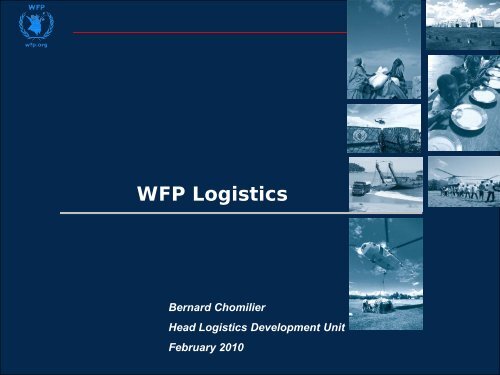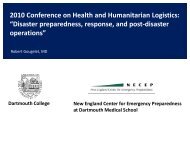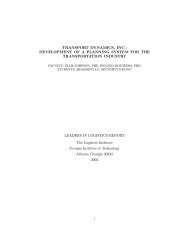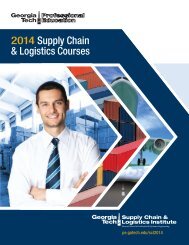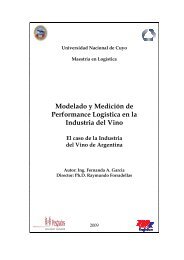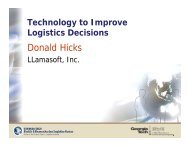WFP Logistics - The Supply Chain and Logistics Institute - Georgia ...
WFP Logistics - The Supply Chain and Logistics Institute - Georgia ...
WFP Logistics - The Supply Chain and Logistics Institute - Georgia ...
Create successful ePaper yourself
Turn your PDF publications into a flip-book with our unique Google optimized e-Paper software.
<strong>WFP</strong> <strong>Logistics</strong><br />
Bernard Chomilier<br />
Head <strong>Logistics</strong> Development Unit<br />
February 2010
Contents<br />
• <strong>WFP</strong> <strong>Logistics</strong><br />
• <strong>WFP</strong> <strong>Logistics</strong> 2009 at a glance<br />
• <strong>WFP</strong> <strong>Logistics</strong> Strategic Direction<br />
• <strong>WFP</strong> <strong>Logistics</strong> in 2010-2011
<strong>WFP</strong> <strong>Logistics</strong><br />
Core purpose:<br />
Save lives <strong>and</strong> protect livelihoods<br />
by providing the leadership <strong>and</strong><br />
logistics capacity required. <strong>WFP</strong><br />
delivers the right product, in the<br />
right quantities, at the right place,<br />
at the right time, at the right cost,<br />
<strong>and</strong> in the right condition. (6Rs)
<strong>WFP</strong> <strong>Logistics</strong> Core Services<br />
•Surface Transport<br />
•Air Transport<br />
•Ocean Transport<br />
•UNHRD<br />
•<strong>Logistics</strong> Cluster
<strong>WFP</strong> <strong>Logistics</strong> 2009 at a glance<br />
• L<strong>and</strong> Transport: 4.97 million MT* h<strong>and</strong>led<br />
• Ocean Transport: 2.4 million MT transported<br />
• Air Transport: 269,703 passengers <strong>and</strong> 8,947 MT cargo<br />
transported<br />
• UNHRD global average monthly stock value st<strong>and</strong>s at US$46.6<br />
million.<br />
• 35 active Special Operations with a total requirement of US$851.5<br />
million <strong>and</strong> a total contributions of US$642.7 million. Shortfall<br />
US$208.8 million (24.5%).<br />
• <strong>Logistics</strong> Cluster: activated in Indonesia, Pakistan, Philippines,<br />
Somalia, Chad, CAR, DRC, Gaza/OPT, Sri Lanka, Haiti <strong>and</strong> Laos.<br />
• 15 St<strong>and</strong>-by Partners Organizations, 68 St<strong>and</strong>-by Personnel<br />
deployed in Jan-Jun 2009.<br />
* L<strong>and</strong> transport figures from Jan-Sep 2009 (Source: COMPAS)
From Preparedness to Response<br />
Centre of<br />
excellence<br />
Customer service<br />
Developing staff<br />
Developing<br />
Systems & tools<br />
Strategic Sourcing<br />
Partnerships &<br />
Coordination<br />
Information flow
Developing Staff<br />
Competence framework <strong>WFP</strong><br />
Technical Trainings<br />
Surface contracting<br />
Port operations<br />
Warehousing mgt<br />
Aviation support<br />
<strong>Supply</strong> chain<br />
management<br />
Transport manual<br />
(quiz)<br />
LTSH fund<br />
management<br />
COMPAS<br />
Procurement<br />
Milling<br />
Emergency Trainings<br />
Technical Field<br />
Operations Training<br />
(TFOT – <strong>WFP</strong><br />
Personnel)<br />
<strong>Logistics</strong> Response<br />
Team Training (LRT –<br />
inter-agency)<br />
P<strong>and</strong>emic training<br />
(P2LX, inter-agency)<br />
Soft skill Trainings<br />
Service Mindset<br />
Training (SMT –<br />
elearning tool)<br />
Management<br />
Training<br />
External Trainings<br />
CHL<br />
CHSCM<br />
Warwick University<br />
TNT – Go Academy<br />
Medical <strong>Logistics</strong><br />
(MedLog)<br />
Specialized training<br />
(flight dispatcher,<br />
GAFTA, etc)<br />
<strong>WFP</strong>’s E-learning Management System (LMS)<br />
Competence framework Humanitarian Community<br />
Available Under development To be decided
Systems <strong>and</strong> tools<br />
<strong>WFP</strong> <strong>Logistics</strong><br />
Centre of Excellence<br />
Customer Service<br />
•<strong>Logistics</strong> Portal<br />
Developing Staff<br />
Developing Tools &<br />
Systems<br />
Partnerships &<br />
Coordination<br />
Information flow<br />
Stock piling Strategy<br />
•KPIs / Dashboard<br />
• <strong>Logistics</strong> Operational guide<br />
• Self Monitoring tool<br />
•Commodity tracking tool<br />
•Flight Management Application<br />
•Fleet Management Software<br />
Performance Improvement
Partnerships & Coordination<br />
<strong>WFP</strong> <strong>Logistics</strong><br />
Centre of Excellence<br />
Customer Service<br />
•<strong>Logistics</strong> Cluster<br />
Developing Staff<br />
Developing Tools &<br />
Systems<br />
Partnerships &<br />
Coordination<br />
Information flow<br />
Stock piling Strategy<br />
•St<strong>and</strong>by partners<br />
•Private Sector support<br />
• Bilateral agreements<br />
•Civil Military Cooperation<br />
•Dept of Peacekeeping<br />
•Academic Institutions<br />
Strengthening collaborative efforts & augmenting capacity
<strong>WFP</strong> <strong>Logistics</strong>: Inter-agency service<br />
• United Nations Humanitarian Air Service (UNHAS)<br />
– Over 200 locations in 16 countries with 58 aircraft<br />
• United Nations Humanitarian Depot (UNHRD)<br />
– Five network hubs in Accra, Dubai, Brindisi, Panama <strong>and</strong><br />
Subang<br />
• <strong>Logistics</strong> Cluster<br />
– Coordination during emergency <strong>and</strong> enhancement of<br />
emergency preparedness<br />
• Service Provision<br />
– Providing logistics services to 59 humanitarian<br />
organizations in 39 countries worldwide.
<strong>WFP</strong> – Leader of the <strong>Logistics</strong> Cluster<br />
Providing the platform for an integrated<br />
<strong>and</strong> more predictable response<br />
through cooperation <strong>and</strong> collaboration<br />
• Fill logistics gaps <strong>and</strong> alleviate bottlenecks<br />
• Prioritize logistics interventions & investments<br />
• Collect/share information & assets<br />
• Trigger & facilitate common logistics services<br />
• Advocacy <strong>and</strong> resource mobilization for<br />
logistics initiatives<br />
• http://www.logcluster.org/
UNHRD Network <strong>and</strong> Partnering<br />
Organizations<br />
UNHRD - A more rapid, efficient <strong>and</strong> cost effective<br />
response<br />
Strategic locations<br />
Inter-agency cooperation: prioritization of the 1st wave deployment<br />
Savings: free storage<br />
Exchange & Loans: multiple stocks of partners<br />
Immediate purchase: stocks of suppliers<br />
Virtual Stocks: through long-term agreements<br />
• All requests centralized through a support office - “One-stop-shop”<br />
Over 30 partnering humanitarian organizations
UNHAS Network Map<br />
• Air support to <strong>WFP</strong> Operations<br />
• Airlifts <strong>and</strong> airdrops for food<br />
• Strategic airlift operations<br />
• Security evacuations<br />
• United Nations Humanitarian Air<br />
Service - UNHAS<br />
More than 200 locations in 16 countries
Service Provision<br />
• Growing humanitarian needs present increased dem<strong>and</strong> for<br />
humanitarian logistics capacity.<br />
• <strong>WFP</strong> <strong>Logistics</strong> began developing its logistics services for the<br />
benefit of <strong>WFP</strong> programmes <strong>and</strong> the humanitarian<br />
community (UN, NGOs, government agencies). We aim to<br />
provide services that are transparent, efficient, reliable <strong>and</strong><br />
predictable.<br />
• Not a new concept; <strong>WFP</strong> has supported other humanitarian<br />
actors in delivery of humanitarian aid with established<br />
logistics capacities <strong>and</strong> infrastructure.<br />
• Zimbabwe: logistics services in response to cholera; SLAs<br />
with three UN agencies (UNICEF, FAO <strong>and</strong> WHO) <strong>and</strong> three<br />
NGOs (GTZ, Care Int. <strong>and</strong> SSA) with contract value in<br />
excesses of US$1 million in h<strong>and</strong>ling <strong>and</strong> transporting NFIs.
Issues/Questions
Education, Community Preparedness,<br />
<strong>and</strong> Capacity Building<br />
Dale Herzog<br />
United Parcel Service (UPS), CARE-USA
Living on the Edge<br />
Why collaboration matters<br />
Dale Herzog<br />
Customer Solutions Manager<br />
UPS<br />
© 2002, CARE USA. All rights reserved.
UPS Humanitarian Outreach<br />
Domestically<br />
• UPS has been <strong>and</strong> will always be actively engaged in relief efforts<br />
• UPS foundation – $100 million in philanthropy<br />
• UPS employees – $52 million to United Way<br />
• UPS Employees log over 1 million hours in volunteer service<br />
Internationally<br />
• 2007 CARE requests logistical help<br />
• 2009 UPS Foundation launches a 2 year $9 million dollar initiative<br />
<br />
Enhance preparedness, strengthen collaboration <strong>and</strong> build capacity<br />
building for disaster relief <strong>and</strong> recovery<br />
• CARE<br />
• UNICEF<br />
• American Red Cross<br />
• World Food<br />
© 2005, CARE USA. All rights reserved.
UPS Corporate Vision<br />
• Leverage UPS Intellectual Capital<br />
<strong>Logistics</strong> – 3PL – Brokerage<br />
• Engage all 5 functions within UPS as contributors<br />
• Become the driving force in motivating other<br />
corporations / foundations to join us as we strive to<br />
improve humanity<br />
Asked as a partner / donor to come in <strong>and</strong> LOOK<br />
Observed that efficiency drives inefficiency<br />
• NGO’s chase a range of 88% to 92%<br />
• Limits capacity building, training, propositioning<br />
<br />
Unrestricted funding needed<br />
© 2005, CARE USA. All rights reserved.
Why CARE Approached UPS<br />
• Atlanta based Organization<br />
• <strong>Logistics</strong> – Core business<br />
• Global Operations (over 200 countries)<br />
• Significant warehousing <strong>and</strong> transport capability<br />
• Established relationship in supporting CARE’s<br />
emergency operations for several years<br />
© 2005, CARE USA. All rights reserved.
Assessment Process<br />
• 3 CARE Country office visits<br />
Honduras, Sudan, Indonesia<br />
• Field perspective received - 4<br />
Country Directors<br />
Peru, Ghana, Somalia, Sri-Lanka<br />
• Interaction with 34 Emergency Team<br />
Leaders<br />
Bangkok workshop<br />
• CARE International Global Conference on<br />
Poverty<br />
Johannesburg, South Africa<br />
© 2005, CARE USA. All rights reserved.
Response Plan<br />
• Identified 25 various sized projects to be<br />
implemented in phases<br />
• Phase 1 – (Structure)<br />
13 projects<br />
Immediate start / implementation<br />
• Phase 2 – (Planning)<br />
4 projects, medium term (19 to 24 months)<br />
• Phase 3 – (Accountability)<br />
8 projects, long term (25 to 36 months)<br />
© 2005, CARE USA. All rights reserved.
Phase 1 Projects<br />
• Commodity Tracking System<br />
• <strong>Supply</strong> <strong>Chain</strong> Unit<br />
• Inventory <strong>and</strong> Warehouse Management Processes<br />
• Prepositioning of Relief Supplies<br />
• Access to partner logistics capabilities through<br />
Consortium partnerships<br />
Tracking – Structure – Processes – Supplies - Movement<br />
© 2005, CARE USA. All rights reserved.
Phase 2 Projects<br />
• Dem<strong>and</strong> forecasting<br />
• <strong>Supply</strong> planning<br />
• Transport planning<br />
• Leverage a deeper relationship with Aidmatrix<br />
Gifts In Kind (GIK) policy linked to web portal<br />
Forecasting – Planning – Relationships<br />
© 2005, CARE USA. All rights reserved.
Phase 3 Projects<br />
• <strong>Logistics</strong> performance review<br />
• Vendor performance review<br />
• Establish feedback mechanism<br />
• Implement training programs<br />
• 4 additional related projects<br />
Review – Accountability – Training - Preparation<br />
© 2005, CARE USA. All rights reserved.
Major Benefits for CARE<br />
• Monitoring & Oversight of supply chain functions<br />
• St<strong>and</strong>ardized processes & procedures<br />
• Commodity visibility & accountability<br />
• Improved timeliness & quality<br />
• Economies of scale<br />
© 2005, CARE USA. All rights reserved.
Major Benefits for UPS<br />
• Introduces / Identifies UPS Br<strong>and</strong> to / within the<br />
humanitarian-relief world<br />
• Opens up potential marketing opportunities<br />
• Opens up opportunities for UPS international employees<br />
to support humanitarian causes<br />
• Assures UPSers we are actively affecting change on a<br />
global basis<br />
© 2005, CARE USA. All rights reserved.
Education, Community Preparedness,<br />
<strong>and</strong> Capacity Building<br />
Gulam Juma<br />
Focus Humanitarian Assistance
Education, Community Preparedness,<br />
<strong>and</strong> Capacity Building<br />
Brian Koon<br />
Walmart
March 4, 2010<br />
Emergency Management<br />
in the Private Sector<br />
Image Area<br />
Bryan Koon<br />
Director of Emergency Management
Why Walmart Has an Emergency Management Department<br />
Three Priorities for Responding to Disasters<br />
• Take care of our people<br />
• Take care of our operations<br />
• Take care of our communities<br />
Emergency Management in the Private Sector 98
Where We Operate<br />
United States<br />
•1.6+ Million associates in 50 States<br />
•4,300+ Retail Outlets<br />
•148 Distribution Centers<br />
•50+ Corporate Facilities<br />
Emergency Management in the Private Sector 99
Where We Operate<br />
Internationally<br />
•700,000 associates in 25 Countries<br />
•4,000+ Retail Outlets in 15 Countries<br />
•40+ Corporate Facilities<br />
Emergency Management in the Private Sector 100
What We Deal With<br />
Emergency Management in the Private Sector 101
How the Department is Organized<br />
Preparedness <strong>and</strong> Planning Section:<br />
• Emergency Procedures, Flip Charts<br />
• Associate, Customer, <strong>and</strong> Member<br />
Preparedness<br />
• Training <strong>and</strong> Exercises<br />
Operations Section:<br />
• Emergency Operations Center <strong>and</strong> Alarm<br />
Central<br />
Recovery / Mitigation Section<br />
Emergency Management in the Private Sector 102
Our Partners<br />
Federal <strong>and</strong> State Interaction<br />
• Direct to DHS <strong>and</strong> FEMA through Private Sector<br />
Offices <strong>and</strong> Infrastructure Protection<br />
• Direct to state emergency management agencies<br />
• Through professional organizations like NEMA,<br />
IAEM, ACP<br />
How we work in State &<br />
Federal EOCs<br />
• WM Associate<br />
Physically Present<br />
• Through<br />
Representative<br />
Organization<br />
• Through Phone & E-<br />
Mail<br />
• Through business organizations like U.S.<br />
Chamber of Commerce, Business Civic<br />
Leadership Council (BCLC), Business<br />
Roundtable, <strong>and</strong> Business Executives for<br />
National Security (BENS)<br />
• Local Relationships maintained by Field<br />
associates<br />
Emergency Management in the Private Sector 103
Our Partners<br />
Charitable Organizations<br />
Emergency Management in the Private Sector 104
What We’re Doing<br />
Preparedness / Awareness<br />
•Initiated a major effort to educate associates in 2006<br />
•1.6 million associates + family members = 1% of U.S.<br />
•Continuous subtle messaging via:<br />
•Email<br />
•Posters<br />
•Internal Television <strong>and</strong> Radio Network<br />
•Intranet links / resources<br />
•Special events<br />
•Targeted Merch<strong>and</strong>ising<br />
•Targeted / regional campaigns<br />
•Weather, geographical or other factors<br />
•Recognition of efforts<br />
•Business to Business through Sam’s Club <strong>and</strong> in<br />
conjunction with DHS Private Sector Office<br />
Emergency Management in the Private Sector 105
Walmart EOC<br />
479-277-1001<br />
emergencyoperationscenter@wal-mart.com<br />
Bryan Koon<br />
479-204-8159<br />
bryan.koon@wal-mart.com<br />
Emergency Management in the Private Sector 106
Education, Community Preparedness,<br />
<strong>and</strong> Capacity Building<br />
Captain Brian Sheppard<br />
U.S. Africa Comm<strong>and</strong>
Building Capacity Through<br />
<strong>Logistics</strong><br />
Capt Brian Sheppard, SC, USN<br />
Chief, <strong>Logistics</strong> Support Division<br />
4 March 2010<br />
1
Bottom Line Up Front -- Why U.S. Africa Comm<strong>and</strong><br />
• Provides dedicated focus on Africa<br />
– Performs military-to military<br />
activities that help build capacity of<br />
African partners <strong>and</strong> foster stability<br />
– Provides crisis response when<br />
directed<br />
• Supports U.S. foreign policy goals<br />
<strong>and</strong> objectives<br />
• Supports U.S. national interests in<br />
Africa<br />
– Fostering free <strong>and</strong> fair markets/trade,<br />
competitive access to resources<br />
– Fostering good governance<br />
– Countering illegal trafficking<br />
– Countering threat of terrorism<br />
110
Many <strong>and</strong> Increasing Opportunities<br />
“Africa will continue to seek Africa's solutions to its problems…”<br />
-- Brigadier General Jean De Martha Jaotody, African Union<br />
•Growing political will to<br />
confront challenges<br />
•Promising regional security<br />
& economic communities<br />
•Increasing democratization<br />
•Rapidly growing economies<br />
<strong>The</strong> key is Stability that allows Africans<br />
to leverage their opportunities<br />
111
U.S. Africa Comm<strong>and</strong> Mission Statement<br />
United States Africa<br />
Comm<strong>and</strong>,<br />
in concert with other U.S.<br />
Government agencies <strong>and</strong><br />
international partners,<br />
conducts sustained security<br />
engagement<br />
through military-to-military<br />
programs, military-sponsored<br />
activities, <strong>and</strong> other military<br />
operations as directed<br />
to promote a stable <strong>and</strong><br />
secure African environment<br />
in support of U.S. foreign<br />
policy.<br />
112
… not the only one’s engaged<br />
28 OFDA Responses in Africa (2008)<br />
47% (8 of 17) United Nations<br />
Peacekeeping Operations are in Africa<br />
Western Sahara (MINURSO)<br />
CAR/Chad (MINURCAT)<br />
Darfur (UNAMID)<br />
Sudan (UNMIS)<br />
Liberia (UNMIL)<br />
Côte d'Ivoire (UNOCI)<br />
DRC (MONUC)<br />
During FY 08 OFDA spent $292 Million in<br />
Africa, more than all other regions combined<br />
Source: OFDA Annual Report for FY 2008<br />
Burundi (BINUB)<br />
Source: Peace <strong>and</strong> Security Section of the<br />
United Nations Department of Public Information<br />
113
114<br />
UNCLASSIFIED//FOUO
115<br />
Use US Military only when it is the best option
<strong>Logistics</strong> Engagements … many organizations<br />
Combined Joint Task Force-<br />
Horn of Africa (CJTF-HoA)<br />
African Deployment<br />
Assistance Partnership<br />
Team (ADAPT)<br />
Providing Exercise<br />
Related Construction<br />
(ERC)<br />
Building Maritime Security<br />
Capacity: Africa<br />
Partnership Station (APS)<br />
Medical/ Veterinary<br />
Civil Action Programs<br />
(MEDCAP/VETCAP)<br />
116
Education, Community Preparedness,<br />
<strong>and</strong> Capacity Building<br />
Bernard Chomilier, World Food Programme<br />
Dale Herzog, United Parcel Service (UPS), CARE-USA<br />
Gulam Juma, Focus Humanitarian Assistance<br />
Brian Koon, Walmart<br />
Captain Brian Sheppard, U.S. Africa Comm<strong>and</strong><br />
Moderator: Leigh Fitzpatrick McCook<br />
<strong>Georgia</strong> Tech Research <strong>Institute</strong>
Working Lunch & Group<br />
Discussions
Improving Public Health<br />
Laurent Dedieu, Doctors Without Borders/Médecins<br />
Sans Frontières (MSF)<br />
Yann LeTallec, Clinton Foundation<br />
Edward Kaplan, Yale University<br />
Mark Keim, Centers for Disease Control <strong>and</strong> Prevention<br />
Nick Pacitti, Sterling Solutions<br />
Moderator: Carladenise Edwards,<br />
<strong>Georgia</strong> Department of Community Health
Improving Public Health<br />
Laurent Dedieu<br />
Doctors Without Borders/Médecins Sans<br />
Frontières (MSF)
Laurent Dedieu<br />
<strong>Logistics</strong> Supervisor, MSF<br />
Meningitis Vaccination Campaign<br />
Nigeria, 2009
WHAT IS MENINGITIS
Main challenges<br />
•Human resources <strong>and</strong> site planning<br />
•Cold chain<br />
•<strong>Supply</strong><br />
•Transport
Vaccination Site Planning
Improving Public Health<br />
Yann LeTallec<br />
Clinton Foundation
Improving global health -<br />
A perspective from the Center of<br />
Strategic Health Operations<br />
Research at the Clinton Health<br />
Access Initiative<br />
Yann Le Tallec<br />
Clinton Health Access Initiative<br />
Humanitarian <strong>and</strong> Health <strong>Logistics</strong> Conference<br />
March 5, 2010
What does the Clinton Health Access Initiative (CHAI) do<br />
CHAI is not a research organization, donor or implementer by nature, but<br />
instead focuses on improving management <strong>and</strong> markets<br />
R&D – New<br />
evidence, models<br />
<strong>and</strong> technologies<br />
Financing for<br />
technologies <strong>and</strong><br />
national programs<br />
HR, infrastructure<br />
<strong>and</strong> management of<br />
implementation<br />
Lower<br />
mortality<br />
CHAI mobilizes<br />
<strong>and</strong> optimizes<br />
the use of<br />
resources<br />
Improved<br />
organization of<br />
commodity markets<br />
More efficient<br />
delivery of health<br />
services <strong>and</strong><br />
more effective<br />
management of<br />
health systems<br />
More<br />
lives<br />
saved<br />
1
CSHOR applies advanced analytical approaches to<br />
improve decision making in global health<br />
Analytical<br />
approaches<br />
People<br />
Global health<br />
questions<br />
• Mathematical<br />
modeling<br />
• Computer simulation<br />
• Probability/statistics<br />
• Optimization<br />
• 15 staff members<br />
• Operations<br />
Research<br />
experience<br />
• Applied<br />
mathematics<br />
• Computer science<br />
• Engineering<br />
• Economics<br />
• Global Health<br />
experience<br />
• Public Health<br />
• Epidemiology<br />
• Need <strong>and</strong> dem<strong>and</strong><br />
forecasting<br />
• Resource planning<br />
• Optimal resource<br />
allocation<br />
• <strong>Supply</strong> chain<br />
management<br />
• Actionable evidence-based recommendations<br />
• Transferable software tools<br />
138
Why Operations Research (<strong>and</strong> other disciplines)<br />
for global health<br />
Historic amount of resources poured<br />
into global health<br />
Yet large remaining gap to access<br />
health<br />
4<br />
3<br />
2<br />
1<br />
0<br />
Amount approved by Global Fund<br />
by round (Billion USD)<br />
1 2 3 4 5 6 7 8 9<br />
50%<br />
40%<br />
30%<br />
20%<br />
10%<br />
0%<br />
ART coverage in LMIC*<br />
42%<br />
33%<br />
5% 8% 15% 22%<br />
2003 2004 2005 2006 2007 2008<br />
Need of Operations Research <strong>and</strong> other expertise to<br />
• bridge the health access gap <strong>and</strong> the resource gap<br />
• address increasingly complex systems <strong>and</strong> operations in global<br />
health<br />
* Antiretroviral Treatment coverage in low- <strong>and</strong> middle-income countries at end of year<br />
Source: Global Fund website, WHO<br />
139
140<br />
Key areas of engagement for CHAI/CSHOR<br />
Area of<br />
engagement Trends in global health Example of responses<br />
Decentralization<br />
of health<br />
services<br />
Human<br />
resources for<br />
health (HRH)<br />
• Expansion of the dispensing network<br />
for health services<br />
• Decentralization of some “advanced”<br />
services to local facilities<br />
• Insufficient supply of qualified health<br />
care workers in poor countries<br />
• Inform trade-off between health<br />
outcome <strong>and</strong> equity vs cost of<br />
decentralization<br />
• Effective decentralized data<br />
collection <strong>and</strong> management<br />
• Reduce gap between supply <strong>and</strong><br />
dem<strong>and</strong> of HRH<br />
• Optimize use <strong>and</strong> deployment of<br />
HRH<br />
Sustainable<br />
financing<br />
Operations <strong>and</strong><br />
supply chain<br />
management<br />
• Large <strong>and</strong> widening gap between<br />
funding need <strong>and</strong> availability<br />
• Uncertain future for health programs<br />
financing <strong>and</strong> impact<br />
• Strained systems <strong>and</strong> operations<br />
supply chain under dramatic dem<strong>and</strong><br />
scale up<br />
• Maximize value from limited<br />
financial resources<br />
• Make sound long-term<br />
investments<br />
• To be detailed in next page
<strong>Logistics</strong> <strong>and</strong> supply chain management for global<br />
health<br />
Area of<br />
engagement Selected questions Examples of CHAI work<br />
Introduction of<br />
new products<br />
• Dem<strong>and</strong> <strong>and</strong> uptake forecasting (e.g., for<br />
supplier negotiations)<br />
• Pricing of new products<br />
• Point of care CD4 counting,<br />
2 nd line TB drugs<br />
• Subsidies for ACTs* to foster<br />
adoption<br />
<strong>Supply</strong> chain<br />
management<br />
<strong>and</strong> optimization<br />
Continuous<br />
improvement of<br />
processes<br />
• Reliable dem<strong>and</strong> forecasting<br />
• Inventory management to minimize stock<br />
outs <strong>and</strong> expiries with unreliable<br />
data/systems <strong>and</strong> heterogeneous needs<br />
• Effective lab <strong>and</strong> people referral network<br />
• <strong>Supply</strong> chain design/re-optimization<br />
• Optimize use of limited resources to yield<br />
high-quality outcomes<br />
• ARV**, ACT, lab re-agents<br />
• India, Dominican Republic,<br />
etc<br />
• Early Infant Diagnostic<br />
• Re-integration of vertical<br />
supply chains (e.g., HIV, TB)<br />
• Space optimization at clinic<br />
• HRH task shifting<br />
* ACT = Artemisinin Combination <strong>The</strong>rapy (for malaria)<br />
** ARV= Antiretroviral (for HIV)<br />
141
<strong>The</strong> challenge of access to information in global<br />
health<br />
142<br />
A challenging information<br />
l<strong>and</strong>scape<br />
What we need to do<br />
• Data is often collected,<br />
especially for donor reporting,<br />
but it is often<br />
• Hard <strong>and</strong> expensive to<br />
access<br />
• Unreliable<br />
• Outdated<br />
• Making better decision with<br />
unreliable data<br />
• Making the case for investing<br />
in improving information<br />
infrastructures<br />
• Building information<br />
processes adapted to global<br />
health systems
Improving Public Health<br />
Edward Kaplan<br />
Yale University
Yale SCHOOL of MANAGEMENT<br />
YALE UNIVERSITY<br />
School of Engineering <strong>and</strong><br />
Applied Science<br />
YALE UNIVERSITY<br />
School of Public Health<br />
Operations Research<br />
<strong>and</strong> Public Health<br />
Edward H. Kaplan, PhD<br />
William N <strong>and</strong> Marie A Beach Professor of Management Sciences<br />
Yale School of Management<br />
Professor of Public Health<br />
Yale School of Public Health<br />
Professor of Engineering<br />
Yale School of Engineering <strong>and</strong> Applied Science
What Is Operations Research<br />
Operations research is the scientific study<br />
of operations for the purpose of making<br />
better decisions<br />
Also refers to mathematical techniques<br />
developed/used by operations researchers<br />
Original applications were military; now<br />
prevalent in supply chain management,<br />
transportation, private/public services,<br />
homel<strong>and</strong> security/counterterrorism, etc.
What Is Public Health<br />
<strong>The</strong> mission of public health is to assure<br />
conditions in which people can be healthy!<br />
Mission is accomplished via the application<br />
of public health science to the design <strong>and</strong><br />
operation of public health services<br />
Operations research (<strong>and</strong> management)<br />
principles <strong>and</strong> techniques can be applied in<br />
both of these areas
Public Health Operations<br />
disease screening/surveillance (e.g. HIV,<br />
influenza)<br />
outbreak investigation (e.g. SARS)<br />
vaccination (e.g. childhood diseases),<br />
quarantine/isolation (e.g. TB)<br />
behavioral modification programs (e.g. STDs)<br />
inspection/st<strong>and</strong>ards enforcement at public<br />
establishments (e.g. restaurants)<br />
environmental monitoring (e.g. bacterial levels at<br />
public swimming areas)<br />
vector control (e.g. mosquitos, ticks, etc.)
American Journal of Public Health<br />
42 (10): 1306-1307 1952
Operations Research<br />
<strong>and</strong> Epidemiology<br />
What is the most famous equation in service<br />
operations management<br />
L = λW<br />
What is the most famous equation in<br />
epidemiology<br />
Prevalence = Incidence x Duration<br />
Any questions
Example: How Many New HIV<br />
Infections Occur in the US Each Year
Application of L = λW :<br />
Estimating HIV Incidence<br />
Parekh <strong>and</strong> McDougal, AIDS<br />
Rev 2001;3:183-193
OR Approach to Needle Exchange<br />
needle exchange reduces needle circulation times<br />
as a consequence, needles share fewer people<br />
as a further consequence, fraction of needles that<br />
are infected should decline<br />
easy to capture this logic with simple model<br />
what was not so easy was to verify it with actual<br />
data from the needle exchange program
Circulation <strong>The</strong>ory:<br />
An Operational Model
Circulation <strong>The</strong>ory:<br />
An Operational Model
Circulation <strong>The</strong>ory:<br />
An Operational Model
Summary<br />
<strong>The</strong>re are many outst<strong>and</strong>ing opportunities<br />
to apply operations research ideas to<br />
improve public health<br />
– methodological contributions to epidemiology<br />
– practical contributions to the design, evaluation<br />
<strong>and</strong> operation of public health activities
Improving Public Health<br />
Mark Keim<br />
Centers for Disease Control <strong>and</strong> Prevention
Emergent use of social media:<br />
A new age of opportunity for disaster resilience<br />
Mark Keim, M.D.<br />
Senior Science Advisor<br />
Centers for Disease Control <strong>and</strong> Prevention<br />
March 5, 2010
January 12, 2010<br />
• <strong>The</strong> Haiti earthquake…<br />
• Killed 230,000<br />
• Injured 200,000<br />
• Changed disaster<br />
management…as we<br />
once knew it
<strong>The</strong> growing role of social<br />
media in disaster management<br />
• Social media<br />
• Form of information<br />
communication<br />
technology<br />
• Designed to<br />
disseminated through<br />
social interaction<br />
• Collaborative,<br />
decentralized,<br />
horizontal, networked,<br />
community-driven
<strong>The</strong> growing role of social media in<br />
disaster management 1,2<br />
• 2007 Virginia tech<br />
shootings<br />
• 2007 Southern<br />
California Wildfires<br />
• 2008 Democratic<br />
Convention<br />
• 2008 Hurricane Ike<br />
• 2009 Iran protests<br />
1<br />
Sutton 2008,<br />
2<br />
Pew Research Ctr 2009
<strong>The</strong> role of media<br />
after the Haiti earthquake<br />
• Traditional media<br />
• Consumers used<br />
traditional media to<br />
obtain information<br />
about the quake<br />
• Social media<br />
• Consumers used<br />
social media to<br />
share information,<br />
react to the<br />
situation <strong>and</strong> to<br />
rally support
• Twitter TM was the<br />
leading source of<br />
discussion about<br />
the Haiti quake 1<br />
• Followed by<br />
• Online video<br />
• Blogs<br />
• Discussion forums<br />
• Two kinds of<br />
tweets<br />
• Links to read news<br />
• Links to take action
Social activism via<br />
• 2.3 million tweets<br />
included the word<br />
Haiti or Red Cross<br />
during the first 48<br />
hours after the<br />
quake 1<br />
• Red Cross raised<br />
$25 million in 2<br />
weeks just by<br />
texting 1 1<br />
Sysymos 2010<br />
Tweets <strong>and</strong> texts
Human resilience as a means for<br />
vulnerability reduction<br />
• Resilience<br />
• <strong>The</strong> ability to cope<br />
with <strong>and</strong> recover<br />
from disasters<br />
• Resilience is<br />
comprised of:<br />
• Absorptive<br />
capability<br />
• Organizational<br />
capacity<br />
• Adaptive capacity
Impact of social media on<br />
disaster resilience<br />
• Social media<br />
builds adaptive<br />
capacity<br />
• Shares knowledge<br />
• Creates flexibility<br />
• Empowers local<br />
responders
Impact on disaster<br />
organizational systems<br />
Users<br />
Sanction<br />
Empowerment<br />
Peer to peer<br />
Public<br />
Non-official<br />
Individual<br />
Hierarchical<br />
Institutions<br />
Official<br />
Organizational<br />
Activation Immediate Delayed<br />
Adaptability<br />
High<br />
Moderate<br />
Accessibility Inclusive Exclusive<br />
Sources of public<br />
information<br />
Many<br />
One<br />
Structure Dynamic Static
Sources<br />
Format<br />
Technologies<br />
Social media<br />
Public<br />
Online discussion forums<br />
Web broadcasting<br />
Weblogs <strong>and</strong> Wikis,<br />
Podcasts, Pictures <strong>and</strong> Video,<br />
Social network platforms<br />
Mobile phones<br />
Computers<br />
Digital music players<br />
Internet<br />
Traditional media<br />
Corporations,<br />
Organizations,<br />
Government<br />
News<br />
Entertainment<br />
Advertisement<br />
Risk communication<br />
Public service<br />
Propag<strong>and</strong>a<br />
Television<br />
Radio<br />
Internet<br />
Information flow Multi-directional Uni-directional<br />
Information control Low High<br />
Adaptability High Low<br />
Relevance for local<br />
High<br />
Low<br />
residents<br />
Intelligence Collective Proprietary<br />
Empowerment Individual Organizational<br />
Accuracy of information Variable Variable<br />
Cost Low High<br />
Accessibility Inclusive Exclusive<br />
Timeliness of information Immediate Delayed
Impact on disaster<br />
organizational systems<br />
• Peer to peer<br />
architecture<br />
• Hierarchical<br />
architecture<br />
IC<br />
Ops Intell Log Admin
Challenges of social media<br />
• Lack of awareness<br />
• Privacy issues<br />
• Quality assurance
Improving Public Health<br />
Nick Pacitti<br />
Sterling Solutions
Improving Public Health<br />
Disaster Response<br />
…Can be a Disaster within a Disaster<br />
<strong>Georgia</strong> Tech<br />
March 4-5, 2010<br />
Nick Pacitti
Discussion Points<br />
• Provide high level insights on logistical<br />
challenges in disaster response<br />
• Focus on supply chain intermediaries<br />
• Areas for further study <strong>and</strong> research
<strong>The</strong>re is a need for further research in analyzing <strong>and</strong><br />
improving logistics systems under extreme conditions<br />
• Extreme events pose serious logistical challenges to<br />
emergency <strong>and</strong> aid organizations - the disturbances they<br />
produce turn normal conditions into chaos<br />
• <strong>The</strong> design of reliable emergency <strong>and</strong> support logistics<br />
systems is hampered by lack of knowledge about how supply<br />
chain members operate <strong>and</strong> interact<br />
• Coordination of priority <strong>and</strong> non-priority goods continues to<br />
be a challenge
<strong>The</strong> role of supply chain intermediaries is a focal point<br />
in improving responsiveness <strong>and</strong> efficiencies. If used<br />
properly, Intermediaries provide a window to the<br />
logistics world.<br />
<strong>The</strong> misuse of intermediaries
With the sophistication of supply chain intermediaries<br />
information <strong>and</strong> product flows can be streamlined
We have more tools <strong>and</strong> quicker access to supply chain<br />
intermediaries for improved <strong>and</strong> more efficient response<br />
Third Generation<br />
( 2000 <strong>and</strong> beyond)<br />
• Online marketplaces<br />
• Web-based 3PLs<br />
• Increasing supply chain integration<br />
Second Generation<br />
(1980s - 1990s)<br />
• Non asset-based companies<br />
• Asset-based companies increased<br />
service offerings<br />
First Generation<br />
(70s -80s)<br />
• Transportation / warehousing<br />
• Freight forwarders / brokers<br />
• Shipper’s agents
ALAN is a significant improvement in coordinating<br />
<strong>and</strong> responding to disasters – formed after the<br />
Katrina disaster<br />
• ALAN serves as a clearinghouse for supply chain expertise,<br />
products, equipment, <strong>and</strong> services<br />
• ALAN uses advanced technology platforms in facilitating<br />
donations <strong>and</strong> logistics support for relief agencies<br />
• ALAN creates an efficient process for providing the right<br />
goods <strong>and</strong> services in the right quantity, at the right<br />
location, at the right time<br />
www.alanaid.org
Third Generation Intermediaries
Third Generation Intermediaries
As we do in the food segment we have to continue to<br />
play out a host of scenarios in terms of probability <strong>and</strong><br />
severity of occurrence
Improving Public Health<br />
Laurent Dedieu, Doctors Without Borders/Médecins<br />
Sans Frontières (MSF)<br />
Yann LeTallec, Clinton Foundation<br />
Edward Kaplan, Yale University<br />
Mark Keim, Centers for Disease Control <strong>and</strong> Prevention<br />
Nick Pacitti, Sterling Solutions<br />
Moderator: Carladenise Edwards,<br />
<strong>Georgia</strong> Department of Community Health
Break <strong>and</strong> Poster Presentations
Keynote<br />
Rear Admiral Scott Deitchman<br />
Associate Director for Terrorism Preparedness <strong>and</strong><br />
Emergency Response, National Center for<br />
Environmental Health <strong>and</strong> the Agency for Toxic<br />
Substances <strong>and</strong> Disease Registry<br />
Introduction by Gregory Abowd<br />
Health Systems <strong>Institute</strong>, <strong>Georgia</strong> <strong>Institute</strong> of Technology
Announcements
Reception/Dinner<br />
<strong>Georgia</strong> Tech Hotel


